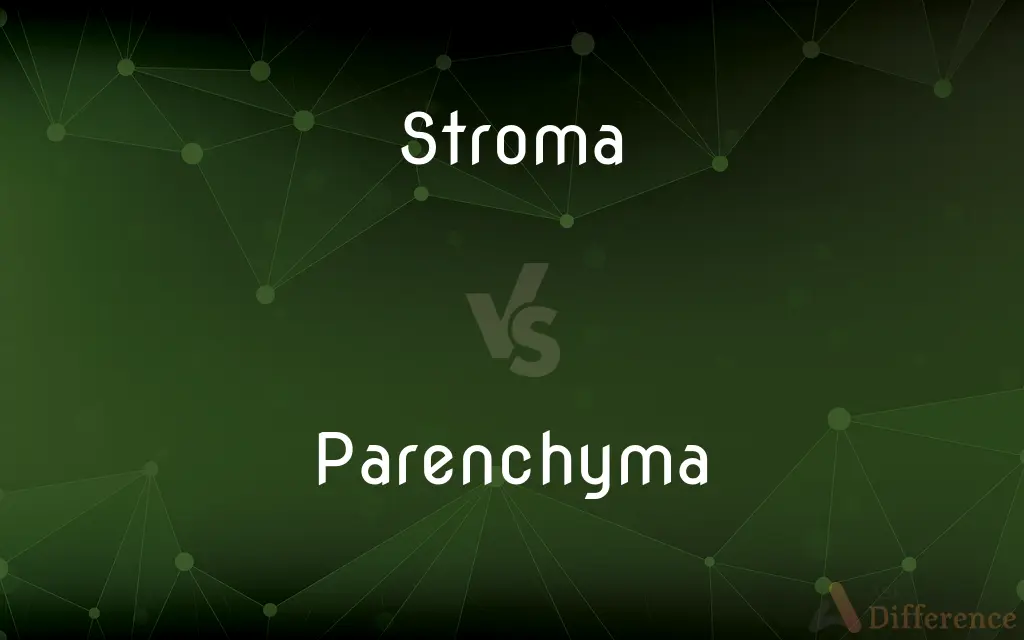Stroma vs. Parenchyma — What's the Difference?
By Maham Liaqat & Urooj Arif — Updated on April 17, 2024
Stroma refers to the supportive tissue in organs, whereas parenchyma consists of the functional cells carrying out specific tasks.

Difference Between Stroma and Parenchyma
Table of Contents
ADVERTISEMENT
Key Differences
Stroma forms the supportive framework of various organs and tissues, providing structure and anchoring functional cells. Whereas parenchyma includes the main functional cells within an organ, directly involved in its specific biological functions.
Stroma often consists of connective tissues, which include collagen and fibroblasts, vital for the physical structure of organs. On the other hand, parenchyma is made up of cells that perform the essential activities of the organ, such as photosynthesis in leaves or filtration in kidneys.
In plants, the stroma is part of the chloroplasts involved in the light-independent reactions of photosynthesis. Conversely, the plant parenchyma includes cells that conduct most of the metabolic functions and can be specialized, such as palisade and spongy mesophyll in leaves.
In animal organs, stroma can also include components like blood vessels and immune cells, contributing to overall organ health and response to damage. Whereas in animals, parenchymal cells would include hepatocytes in the liver or nephrons in the kidneys, which perform the critical functions of these organs.
Comparison Chart
Definition
Supportive tissue framework within organs.
Functional tissue in organs, responsible for primary organ functions.
ADVERTISEMENT
Composition
Mainly connective tissues, including collagen and fibroblasts.
Cells specific to the organ’s function, like photosynthetic cells in plants.
Function in Plants
Structural support in chloroplasts; involved in light-independent reactions.
Performs photosynthesis, storage, and other metabolic processes.
Function in Animals
Provides structure, houses blood vessels and immune cells.
Carries out essential organ functions, such as filtration in kidneys.
Examples
Collagen in skin, fibroblasts in connective tissues.
Hepatocytes in liver, nephrons in kidneys.
Compare with Definitions
Stroma
Supportive framework in an organ.
The stroma in the liver consists of connective tissues that support hepatocytes.
Parenchyma
Primary functional tissue of organs.
The parenchyma of the lung includes alveoli, crucial for gas exchange.
Stroma
Structural component in chloroplasts.
The stroma in chloroplasts contains enzymes for the Calvin cycle.
Parenchyma
Photosynthetic tissue in plants.
Leaf parenchyma are involved in the process of photosynthesis.
Stroma
Often contrasted with parenchyma in medical contexts.
In cancer studies, researchers focus on changes in both the stroma and parenchyma.
Parenchyma
Metabolically active cells in organs.
The renal parenchyma includes structures essential for urine production.
Stroma
Connective tissue component.
Fibroblasts in the stroma help repair tissue damage.
Parenchyma
Differs from stroma in role and structure.
Unlike stroma, parenchyma performs the essential functions of the organ.
Stroma
Contains immune and blood vessels in some organs.
The stroma in the lymph nodes contains lymphatic vessels.
Parenchyma
Can regenerate and repair in some organs.
Liver parenchyma can regenerate after partial hepatectomy.
Stroma
The connective tissue framework of an organ, gland, or other structure, as distinguished from the tissues performing the special function of the organ or part.
Parenchyma
Parenchyma () is the bulk of functional substance in an animal organ or structure such as a tumour. In zoology it is the name for the tissue that fills the interior of flatworms.
Stroma
The spongy, colorless framework of a red blood cell or other cell.
Parenchyma
(Anatomy) The tissue characteristic of an organ, as distinguished from associated connective or supporting tissues.
Stroma
The colorless semiliquid material inside a chloroplast, in which the thylakoid membranes are embedded and where the dark reactions of photosynthesis occur.
Parenchyma
(Botany) A simple plant tissue, composed of thin-walled cells and forming the greater part of leaves, roots, the pulp of fruit, and the pith of stems.
Stroma
A dense mass of fungal hyphae on or in which reproductive structures develop.
Parenchyma
(anatomy) The functional tissue of an organ as distinguished from the connective and supporting tissue.
Stroma
(anatomy) The tissue structure of an organ, etc., that serves to support it.
Parenchyma
(botany) The cellular tissue, typically soft and succulent, found chiefly in the softer parts of leaves, pulp of fruits, bark and pith of stems, etc.
Stroma
The connective tissue or supporting framework of an organ; as, the stroma of the kidney.
Parenchyma
(zoology) Cellular tissue lying between the body wall and the organs of invertebrate animals lacking a coelom, such as flatworms.
Stroma
A layer or mass of cellular tissue, especially that part of the thallus of certain fungi which incloses the perithecia.
Parenchyma
The soft cellular substance of the tissues of plants and animals, like the pulp of leaves, the soft tissue of glands, and the like.
Stroma
The dense colorless framework of a chloroplast
Parenchyma
Animal tissue that constitutes the essential part of an organ as contrasted with e.g. connective tissue and blood vessels
Stroma
The supporting tissue of an organ (as opposed to parenchyma)
Parenchyma
The primary tissue of higher plants composed of thin-walled cells that remain capable of cell division even when mature; constitutes the greater part of leaves, roots, the pulp of fruits, and the pith of stems
Common Curiosities
How does the parenchyma contribute to organ health?
Parenchyma cells perform the organ’s essential functions, such as metabolism and secretion.
What is the main difference between stroma and parenchyma?
Stroma is the supportive tissue, while parenchyma refers to the functional cells of an organ.
Do stroma and parenchyma interact?
Yes, they interact extensively, with stroma supporting parenchyma cells and contributing to their function.
Can stroma turn into cancer?
Yes, cells in the stroma can become cancerous, leading to sarcomas.
Are stroma cells active in organ functions?
Stroma cells mainly provide support and structure, but they can contribute to functions like healing and defense.
How does parenchyma vary among different plants?
Plant parenchyma varies, from photosynthetic tissues in leaves to storage tissues in roots and stems.
Are there diseases associated specifically with parenchyma or stroma?
Yes, certain diseases specifically affect either the stroma or parenchyma, impacting their respective functions.
Can stroma and parenchyma be found in all organs?
Yes, most organs have both stroma and parenchyma, each serving different roles.
What happens if the parenchyma is damaged?
Damage to the parenchyma can severely affect the organ's function, possibly leading to organ failure.
Is the stroma vascularized?
Yes, stroma often contains blood vessels, which supply nutrients and oxygen.
Does damage to stroma affect parenchyma?
Yes, damage to stroma can compromise the structure and support for parenchyma, affecting the organ's function.
How is stroma studied in medical research?
Medical research studies stroma to understand its role in organ development, disease, and regeneration.
What role does stroma play in chloroplasts?
In chloroplasts, the stroma contains enzymes for the Calvin cycle, crucial for sugar synthesis.
How do parenchymal cells adapt in different organs?
Parenchymal cells adapt by specializing in tasks necessary for the specific organ’s function, like filtration in kidneys.
Can the function of parenchyma be replaced?
Some parenchymal functions can be mimicked or supported by medical devices or treatments, but not all.
Share Your Discovery

Previous Comparison
Extermination vs. Termination
Next Comparison
Feasible vs. NonfeasibleAuthor Spotlight
Written by
Maham LiaqatCo-written by
Urooj ArifUrooj is a skilled content writer at Ask Difference, known for her exceptional ability to simplify complex topics into engaging and informative content. With a passion for research and a flair for clear, concise writing, she consistently delivers articles that resonate with our diverse audience.















































